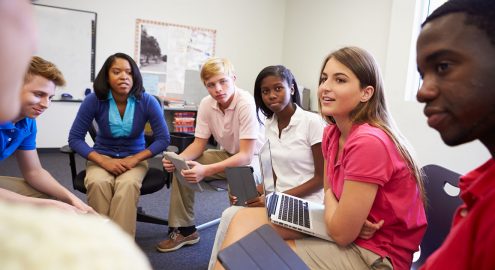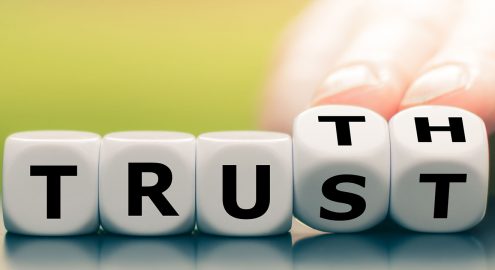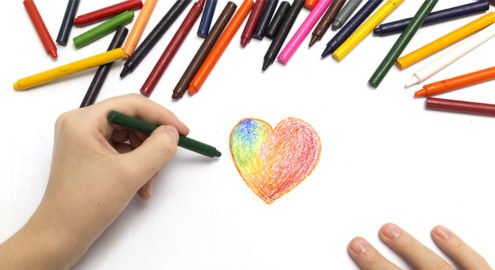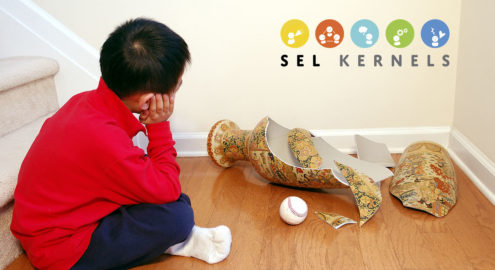What Is It?
According to the Collaborative for Academic, Social, and Emotional, Learning (CASEL), social-emotional learning (SEL) is “the process through which all young people and adults acquire and apply the knowledge, skills, and attitudes to develop healthy identities, manage emotions and achieve personal and collective goals, feel and show empathy for others, establish and maintain positive relationships, and make responsible and caring decisions.”
Responsible decision-making is one of the five components that make up CASEL’s model of SEL. It means the ability to make caring and constructive choices about how to behave, based on consideration of ethical standards (i.e., “benefits and consequences for personal, social, and collective well-being”) as well as relevant social norms and safety concerns.
Here, we use the term ethical decision-making and responsibility for this component in order to emphasize the ethical dimensions of what it means to make decisions that are both personally and socially responsible. From small, everyday choices to larger and more consequential ones, students face a myriad of decisions with ethical implications. How do they decide to do the right thing, or even what “the right thing” is?
A student’s best friend has been having trouble in math class and asks her if she would be willing to help him on a take-home assignment. Their teacher clearly specified that this assignment was to be done individually.
A student witnesses some of his classmates teasing a new classmate who recently arrived from another country. They mock his accent and make fun of how he dresses. The student who sees this feels uncomfortable, but everyone else seems to be laughing along. He worries that if he intervenes, he will become a target himself.
Skills involved in ethical decision-making and responsibility include:
- Demonstrating curiosity and open-mindedness
- Learning how to make a reasoned judgment after analyzing information, data, and facts
- Making ethical decisions based upon mutual respect and appropriate culturally-relevant social norms
- Recognizing one’s responsibility to behave ethically
- Identifying solutions for personal and social problems
- Anticipating and evaluating the consequences of one’s actions
- Recognizing how critical thinking skills are used both inside and outside of school
- Reflecting on one’s role to promote personal, family, and community well-being
- Evaluating personal, interpersonal, community, and institutional impacts
The concept of ethical decision-making and responsibility is closely tied to the other components of SEL. For example, to do the right thing by standing up to friends who are mistreating others, a student needs to be in touch with their own values (self-awareness) and be able to regulate conflicting emotions (self-management); they also need to be able to empathize with those affected (social awareness) and resist peer pressure to join in (relationship skills).
Why Is It Important?
Research on moral development and character education helps us understand the benefits of cultivating students’ abilities to navigate ethical decisions and act in socially responsible ways. (Note: Though they sometimes have distinctions in meaning or connotation, the terms “ethical” and “moral” are generally used interchangeably.)
Without a moral foundation, efforts to promote students’ social-emotional skills and achievement may have unintended consequences.
- Young women who are higher in emotional intelligence (empathy, emotion regulation, etc.) may actually be more likely to engage in delinquent behavior, showing that social-emotional skills alone are not enough to ensure responsible decisions.
- Students at schools that emphasize only performance character (qualities that support achievement, such as perseverance and creativity) are significantly less committed to academic integrity—in other words, they are more likely to cheat—compared with students at similar schools that emphasize moral character (qualities that relate to striving for ethical behavior).
- If we recognize problems in the world and want our students to contribute to solving them, we have to not only prepare them to adapt and succeed in the world as it is, but also equip and encourage them to critically evaluate the world and work to change it for the better.
When teachers incorporate moral development principles into their classroom management and teaching, students respond better and show improved reasoning abilities.
- Across cultures, when judging social situations, both adults and children (as young as three-year-olds) can distinguish between issues that are moral (inherently right or wrong, such as because they hurt people or are unfair) and aspects that involve other considerations (e.g., social norms, rules dictated by authority, personal choices, safety). When deciding what to do, we have to balance between these different domains of social knowledge.
Kids know that hitting someone else for no reason is wrong. Even if their teacher said it was OK, or if they went to a different school where everyone did it, it would still be wrong, they say. On the other hand, if asked whether it’s OK to wear a swimsuit to class, they would likely say no–but if the principal allows it, or if it’s the tradition in another school, then it’s probably all right.
- When teachers respond to student misbehavior in a way that matches the domain of the transgression—for example, responding to a moral transgression (e.g., hitting) by talking about the harm done, and responding to a breach of a norm (e.g., talking out of turn) by referencing the classroom rules and disruption to order—students rate the responses better, and rate the teachers as more knowledgeable and effective.
- When discussion of social domains is integrated into the academic curriculum—such as by explicitly discussing which features of historical events had moral implications and which features had to do with social conventions–students show higher levels of reasoning and a greater ability to balance different considerations.
Strengthening students’ moral identity (how important being a good person is to their sense of self) encourages them to make ethical decisions.
- Moral reasoning (figuring out what is right or wrong) and moral identity (wanting to be a person who does the right thing) are both important for ethical decision-making, especially in difficult situations.
- Moral identity is linked to moral action, such as donating money to charity, and to moral emotions, such as caring about people different than oneself and feeling guilty after doing something wrong.
- Giving students simple cues, like having them read lists of moral principles or write stories using moral terms, can remind them of their moral identity and make them more likely to behave prosocially; on the other hand, giving students performance-based incentives may turn them away from moral identity, making unethical behavior like lying or cheating more likely.
- When students have a strong, internalized moral identity, they are more motivated to behave prosocially even when they don’t get any recognition for it; teachers can help encourage this by focusing students on the internal (vs. external) rewards of doing the right thing.
- Involving students in community service, including giving them opportunities to reflect on their experiences, can help develop their values and identities as moral people.
Reducing moral disengagement (when people do things that they know are wrong, but distance themselves from the actions and consequences) helps students do the right thing more often.
- Students with stronger moral identities, as well as more empathy, are less likely to be morally disengaged; moral disengagement is more likely when students are cynical and feel that things are out of their control.
- Moral disengagement, unsurprisingly, is linked to unethical decisions and behavior. In children and especially adolescents, moral disengagement is related to aggression and bullying.
- Using ethical tools as simple as an honor code can remind students of their moral values and identities, and thus reduce moral disengagement and unethical behavior.
Educators are constantly communicating values and ethical messages to students, whether they mean to or not.
- Though some people may feel that school is not the best place for students to learn about morality, the truth is that the work of teaching is inherently moral. Schools and teachers convey moral messages (i.e., what is right vs. wrong) and other values (i.e., what is important, desirable, etc.) all the time, in both explicit and implicit ways.
- The pattern of implicit ways in which schools socialize students and convey values–not through the academic curriculum, but through school policies, priorities, climate, interpersonal interactions, etc.– is known as the “hidden curriculum.”
- By explicitly addressing values and ethical issues with students, educators can be more intentional about the messages they convey; this also encourages students to consciously and critically reflect on their own values as well as the messages they receive.
Practices

Student Self Check-In Journal

Challenging Gender Stereotyping and Homophobia in Sports

Compass Points

Confronting the -isms

Respectful Debate

Yes-No-Maybe Current Event Discussion

Norm Co-Creation

Take-Home Skill: Creating Happy Memories

Honesty Commitment for Students

Take-Home Skill: Making Amends for Kids

Where We Stand

Standing Up Against Discrimination

Understanding Prejudice Through Paper Plate Portraits

Dear Abby: An SEL Kernels Practice for Sixth Grade

Dear Abby: An SEL Kernels Practice for Fifth Grade

Dear Abby: An SEL Kernels Practice for Fourth Grade

Dear Abby: An SEL Kernels Practice for Third Grade

Dear Abby: An SEL Kernels Practice for Second Grade

Are you ready to build a kinder, happier school where everyone belongs? Join Greater Good Educators! Explore the science of well-being in a supportive community of educators from around the world. Registration is now open for the 2025-2026 school year!




